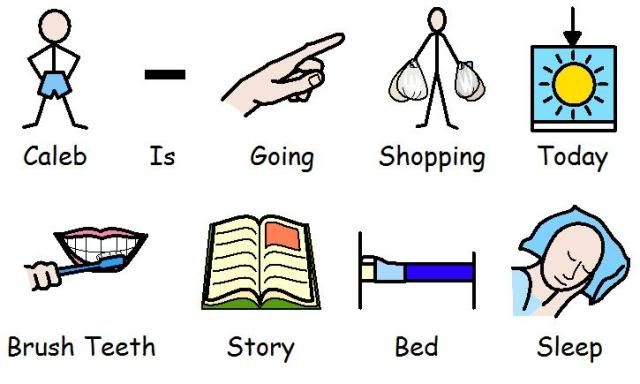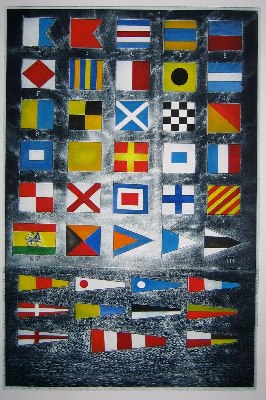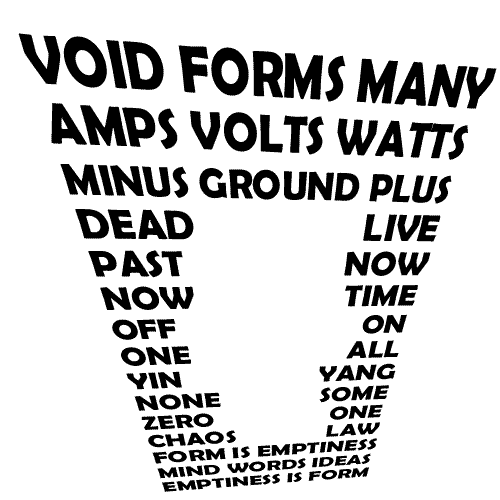Text we R, text i AM
Text, to me, is what we are, what I am. I love words and everything they make us and give us. I love reading. I love seeing words. In this information age, text defines us and gives us life. Text has allowed us to progress and move forward, but it has also isolated us from one another. We no longer need to seek the company of others in person. We can enclose ourselves in the safety of our homes and take on any persona our imagination allows. To me, text is me. It is the first time my daughter spells her name with the inverted C.
I chose the above concrete poem to represent what text is to me because it conveys what text is. It does an excellent job of illustrating the depth and breadth of text in modern languages.
September 16, 2009 No Comments
Text and Technology

What is text? Is its classification still the same as it was when I was in school? Or my parents?
Do we allow for the shortened, grammatically incorrect form of language to be applied to this same category? The kind that is seen in countless text messages or quickly written emails?
Text comes in many forms, including the use of braille for those who have vision difficulties.
When I think of text and technology, I think of my students who cannot write. Those who use software that conveys an image or multiple images into a logical sentence or story. Boardmaker software, as shown above, is one example of how one can express their thoughts, and feelings without using the conventional alphabet.
Though I must ask: Is it still text?
September 16, 2009 2 Comments
‘Texting’

I’m not sure if this really satisfies the requirements. It’s not a definition but it is about text, sort of…
I was at an art gallery recently to look at the preview of a show that was about to open. The pieces were by Canadian artist David Blackwood. The gallery was pretty well empty that day except for the artist who was there to see how the show looked. We ended up having a long conversation, part of which involved this painting of flags. You can’t see it in this image but the flags all have letters of the alphabet underneath them. He told me how these flags would have been the main form of communication on the sailing ships. The idea was that during a battle there would be so much smoke at deck level that they would use the flags so they could be seen above the smoke. Apparently every captain would have someone standing next to him who would take messages and then run the message to the flag person, who would then hoist up the message. He gave the image of the man on Nelson’s ship running up the message, ‘England…expects…that…every…man…’. etc. This started me thinking along two lines. The first was how they were using text but re-invented the look of the text. Instead of letters being represented by lines and squiggles, now it was done with pictures, and a series of pictures could spell a word that someone else could easily understand. Which I guess means that any group can invent their own text. Which brings up my second thought. It seems like it would be a long long process to send a message that spelled words out with flags, so I wondered if maybe there was a recognised form of shorthand, and maybe the changes that are being made with text today, now that it’s become a verb, ‘texting’, in fact go back a long way. It would delight me to think that the flag person on Nelson’s ship was putting up a message along the lines of, ‘CU L8TR’.
September 16, 2009 No Comments
Textual Systems

news obsession word flow experiment #1, originally uploaded by Samuel Huron.
September 16, 2009 No Comments
Face-off: OED and Wikipedia
I am not nearly as brave as Drew, although we used the same springboard. He posted a wonderful multimedia interpretation. I’m afraid I’d be too incoherent. Six classes, three meetings, and twelve hours later, I will be grateful if I can form thoughts and type them. But here it goes…
The OED and Wikipedia connection and comparison offered in Module 1 is interesting. In my position teaching college students research skills, I am often called into classroom to destroy the authority of Wikipedia. Instead, I highlight its wonders and woes as I would with any resource.
Consulting Wikipedia for text was enlightening. There are eight entries. The longest by far is for the recent text messaging. The eight entries have multiple sub-headings and present very detailed accounts of text messaging’s social impact and worldwide use. Other entries of note are for the Swedish band, Text, and text as it applies to computing, “ordinary, unformatted, sequential file.” I started to ruminate on the entry for text as it relates to computing, (and might add another post) but decided to stay on course for the course.
Text (literary theory) needs to be “wikified to meet Wikipedia’s quality standards.Please help by adding relevant internal links, or by improving the article’s layout”. The other entry similar to OED, referring to the Bible/scripture, has no link to further information.
I’m reminded of Ammon Shea, author of Reading the OED: One man, one year, 21 730 pages, who described the OED as “a catalog of the foibles of the human condition”. It’s a reflection of its time, an historical perspective. The OED attempts to align with current communication and incorporate new word styles once they graduate from fads (CBC has wonderful, short segments lamenting additions from Homer’s “Doh!” to cyberphobic) but cannot keep pace with the ferocity with which Wikipedia grows.
The OED’s James Murray relied on Dr. William Chester Minor for close to ten thousand submissions while Wikipedia relies on millions from the masses. Dr. Minor was a murderer, clinically insane, and committed to an asylum. (The Professor and the mad man: A tale of murder, mystery, and the making of the Oxford English Dictionary details their extraordinary relationship as well as the building of the OED.)
I don’t mean to be delivering book reports, but the above helped me situate the two terms we’ve been deliberating – text and technology. I return to Drew’s post where he highlighted their interconnectedness. I do not argue against his thoughtful conclusions, but offer a twist. The emergence of technology forced a growth or manipulation of the understanding of text. As technology took hold, the other had to adapt or was adapted. I appreciated the images of weaving in the reading and on this blog, but am wondering if, in this case, there’s more of a push-pull; if technology isn’t subsuming text? And if so, what does this forecast?
I must truly be tired… as Derrida springs to mind. The relationship between the signifier and the signified shifts. There is nothing concrete and the signified varies in context – culture, time, etc. As I’ve just dumb-downed Derrida, I should stop. Actually, I should most likely wait until text‘s entry is wikified or be proactive and perform the ‘wikifying’ to create my own wikiality. (I’ve been trying to link to Stephen Colbert’s clip for half an hour, but am left hanging each time and now the icons are greyed out.)
September 16, 2009 No Comments
Reflections…
In this first Module, I think we all learned how to get acquainted with new resources. Personally, I’ve never used Vista or a Weblog, so it has taken me quite some time to try to figure out the “method”, pace or way to do the assignments.
Although Vista has a more structured format, I’ve found the Weblog to be much more user friendly. I can check others’ postings easier, and now that we have new features (authors, dates, etc.) it’s easier to look for information within the blog.
As students and teachers (most of us are active teachers), I think it is essential to get acquainted with new technological resources. This is the first course I’m taking directly with UBC and it’s my first experience using “alternative” delivery modes- we always used Blackboard at ITESM. These new resources push us to learn new things, force our brains to work a bit harder and to find the solution to technical problems we’ve all had.
One great advantage I see in the weblog over Vista, is that we’ll be able to see the postings we’ve made after the course has ended (or at least I think I do). We probably won’t be able to sign in as users, but we’ll be able to read older posts.
Ceci
September 16, 2009 No Comments
Technology and Nature Fusion

I must say it took me ages to get on to the blog because I did not click on a hyperlink. I am relieved that I am finally able to share in the discussion which I have been silently involved in since September 8. I have been fascinated with the etymology of the words we have been exploring. Before exploring the denotative meanings of the words, I wrote down my initial understanding of them and discovered that I was somewhat misguided and narrow in my thinking. I saw technology as predominantly man-made. Yet my attitude and instinctive actions are contrary to what I thought were my original views. Though I felt that these were man-made devices which are expensive and difficult to manipulate; that did not stop me from acquiring them, one after the other-computer,cell phone and recently Laptop! I realize that internally I have been viewing technolgy as scientific inventions that are created for humans by humans. Thus I am beginning to formulate a philosophy that technology has evolved naturally and will continue to evolve and expand heavily dependent on the innate desire of human beings to venture into new frontiers. In other words, our trajectory trek from papyrus to cyberspace riddled with gains and losses could not have happened without humankind wanting the mission accomplished. To some extent we are the masters of nature!
Delphine
September 16, 2009 No Comments
Assessment and blogs
The thought came to me last night that if I were to use a blog in my class, similar to this one, how would I go about assessing the work my students contributed? I’ve used a wiki and found the rubric I had created for the assignment was easily transferrable. Are there any thoughts on that? Anyone use blogs in the high school classroom yet?
September 16, 2009 4 Comments
Melding the two T’s
I have used wikipedia to define some of the commonly held meanings of the words text and technology. I believe the melding of these two words demonstrates the interconnectedness of text and technologies and their significance in the 21st century. D. Ryan

September 16, 2009 2 Comments
The question concerning technology.
Martin Heidigger (1977), in his pivotal essay, “The question concerning technology” deconstructs and examines the essence of technology. I have to admit that this piece of work was one of the most challenging pieces of philosophy that I have encountered so far in not only my MET but in my academic career.
That being said, the essay examines in depth what technology is. Heidigger contends that “the essence of technology is nothing technological” (Heidigger, 1977, p.4) but is instead a system. It is really not an end in itself but a way of doing things as well as being a human endeavour. Or put in another way, technology is far more then just things. An examination of technology with this view of technology being a material object essentially produces “blind spots” so that we cannot fully examine the scope and range of what human’s relationship with technology is. Even a definition of technology as being a human endeavour that strives to achieve to get something done, does not go far enough for Heidigger’s tastes.
I have to admit it is at this point of the essay that I become lost in all the terminology (enframing, revealing, Gestell and shining forth). I would welcome a further “revealing” of the essence of “The question concerning technology.” I apologize for the confusing post and for some even bring up Heidigger however a blog post concerning technology that at the very least does not mention Heidigger would be a “incomplete”.
Work Cited
Heidigger, Martin (1977). The question concerning technology. Downloaded on September 16, 2009 from
http://www.wright.edu/cola/Dept/PHL/Class/P.Internet/PITexts/QCT
September 16, 2009 No Comments
Reflections…by Tracy Gidinski
I’ve much preferred using a blog system to the Vista system for several reasons:
- I’m familiar with it as I have been experimenting with different blogging platforms for several years, and prefer Word Press to other platforms.
- It has a simpler interface
- I love the ease of being able to upload images and other media.
I find myself, however, copying my own posts to a new version of my own personal blog (that I set up a while ago, but just started really using for this course), just so I can see my posts in one place (even without the comments from others). If I could design the ultimate interface for this (i.e., if I had the technological skill to do this), I would love to see us writing on our own personal blogs, with any of our posts with, for instance, the category “etec 540” be automatically shown here (with the ability to add comments to either location). That way, we could view our own posts in one location (including things unrelated to this course, perhaps), view others’ posts on their own blogs, or view the entire upload of etec 540 posts on this site. But alas, I don’t have that technological prowess.
Is there a way to have the ability to go to the next page of older posts on this? I find I have to read daily in order not to miss any posts, and due to a (minor) car accident last week that played with my shoulder and made sitting at the computer a little uncomfortable for a short time, I missed a lot of information. (The shoulder is now fine and the car is under repairs, by the way.)
I wonder, though, if the use of a blog changes the formality of our writing? I find myself writing in a style that is different than the posts from my previous coursework because of the fact that it is a blog. For instance, my use of parenthesis in this post is indicative of the style I use while on Facebook, when writing emails to friends, or, to some extent, when writing blog articles on my school blog to my students. Perhaps this phenomenon is affecting just myself, and I should be using a stricter level of formality in these posts.
September 16, 2009 4 Comments
Technology is…by Tracy Gidinski
To continue from my “Text Is” post, this quotation from Ayn Rand summarizes my thoughts on what technology is fairly well:
Technology is an applied science, i.e., it translates the discoveries of theoretical science into practical application to man’s life. As such, technology is not the first step in the development of a given body of knowledge, but the last; it is not the most difficult step, but it is the ultimate step, the implicit purpose, of man’s quest for knowledge. (Ayn Rand. Apollo 11. The Objectivist, Sept. 1969, 9.)
Rand describes technology as the “ultimate step” in the quest for knoweledge, yet new technologies implicitly create the ability for future technologies. In relation to text, then, technology is its leading edge – technology paves the way for new forms of text, which leads to new forms of thinking, on a continual “quest for knowledge.”
Or is it? Instead of a leading edge, do text and technology work together as a double-edged sword? Is text the leading edge for technology in the same way that technology is the leading edge for text?
September 16, 2009 No Comments




